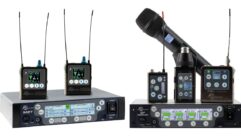
Technology Showcase: Floor Monitors
Jun 1, 2004 12:00 PM,
By John McJunkin
D.A.S. Pf-012
Any systems integrator worth his or her salt will tell you that a monitor engineer is just as important in the grand scheme of things as the front-of-house (FOH) engineer, regardless of the fact that the person at FOH is revered as the
sound engineer
. If the performers’ timing and tuning are off as a result of the inability to hear what’s happening, there’s nothing in the world that FOH can do to fix it. Monitors are crucial to a good performance. Although in-ear monitors continue to gain acceptance and popularity, there are still many musicians who simply prefer to have a floor wedge or two in front of them, probably for the same reason that records are mixed mainly with monitors and not with headphones. I have gathered information about current two-way floor monitors with 12-inch woofers. There are lots of choices out there, and I don’t claim to represent every such speaker in the world, but this guide should get you started. The listings range from the low end to the high end and all points in between.
ON THE FLOOR
The Architectural Acoustics FMW 12 enclosures can be situated at 30- or 45-degree angles for greater pattern control and flexibility onstage. The FMW 12 uses a BWX woofer with a Kevlar-impregnated cone and an RX 22 compression driver coupled to a CH 3 constant directivity horn. The FMW floor monitors are painted off-white or with scuff- and scratch-resistant textured black paint.
Bag End offers the TA1200-CF and TA2000-CF monitors, which are similar save for the size of the cabinets. The TA1200 is slightly smaller and lighter, lending more portability. Otherwise, these are essentially the same speaker. The 80-by-60-degree horn common to both can be rotated to change dispersion. Both models feature Bag End’s proprietary Time-Align circuitry, which ensures that the time offset between the two drivers is less than 25 µs, yielding nice phase-coherent monitoring.
Behringer’s Eurolive F1220 floor wedge sports a frequency response from 50 Hz to 18 kHz (-10 dB). Its dispersion is 90-by-40 degrees, and its crossover point is at 2.5 kHz. It has a self-contained crossover, but it can also be biamped.
Community has three distinct 12-inch, two-way floor wedges: the M12, the MVP28, and the XLT41E. The slick M12 exhibits a curved face and is made of multilayer glass composite. It has an internal crossover but is also biampable, with the high-frequency driver exhibiting 90-by-40-degree dispersion. The MVP28 is a more traditional floor wedge in an angled-baffle configuration, with a 90-by-40-degree high-frequency dispersion characteristic. The internal crossover lives at 2 kHz, and the speaker features high-frequency driver protection. The XLT41E is a multipurpose, two-way loudspeaker that can be used as a floor wedge. This is the most sophisticated of the three Community offerings, with broadband overdrive protection, 420W to 600W power handling at 8ž, and 13-ply Baltic birch construction (as opposed to the medium-density fiberboard or composite construction of the other two models.)
Crest offers the LH5M, a floor wedge that can handle 400W continuous power, 800W program, and 1,600W peak. Its high-frequency driver disperses over a 90-by-60-degree pattern. A standmount adapter enables its usage as a side fill as well. It’s made of seven-ply poplar plywood and features Neutrik Speakon connectors.
d&b MAX12

The MAX12 from d&b is a low-profile wedge. Its marine plywood cabinet incorporates handles and has threaded inserts and a socket for use in speaker-on-a-stick applications. The 2-inch high-frequency driver is coaxially mounted with the 12-inch low-frequency driver, yielding a high degree of phase coherency with 80 degrees of conical dispersion. Numerous active amplification options are available from d&b, or the speaker can be driven by another amplifier. A built-in highpass filter fixed at 130 Hz can be incorporated for use with a subwoofer, and a CPL circuit compensates for coupling effects when several cabinets are used to build a closely coupled array. Frequency response in floor-wedge configuration (floor-coupled) is 80 Hz to 18 kHz. Maximum sound-pressure level (SPL) averages 132 dB.
Spain’s D.A.S. presents the Pf-012. This floor wedge handles 300W continuous, 600W program, and 1,200W peak power at 8ž. The high-frequency driver exhibits a 105-by-75-degree dispersion pattern. The speaker is constructed from complex aggregate board, a high-density, hardwood aggregate board.
EAW SM12

Eastern Acoustic Works (EAW) has four distinct models of 12-inch, two-way floor wedges: the SM12, the SM129z, the SM200iH, and the SM260iV. The SM12 presents a wide frequency range (from 60 Hz to 17 kHz, ±3 dB.) This monitor is made of Baltic birch and is intended for biamplification. Its power handling is formidable, with the low-frequency driver able to contend with 700W and the high-frequency driver taking 200W, both continuous. The SM129z is a multipurpose speaker that can be used for stage monitoring and P.A. work. The shape of its box thus presents a higher profile by way of comparison. It’s not intended for biamped usage, and it handles 450W continuous. The SM200iH is a biampable floor wedge. Dual baffle angles of 15 or 40 degrees are available, the low-frequency driver can handle 500W, and the high-frequency driver can take 200W continuous. In Full Range mode, it loads 6ž, and when biamped the low-frequency driver exhibits 6ž impedance and the high-frequency driver loads 10ž. EAW’s SM260iV is also biampable and includes a comparatively larger two-inch exit compression driver for high frequencies. It exhibits a pentagonal shape that yields a 40-degree baffle angle. Its published frequency response is from 70 Hz to 18 kHz, ±3 dB.
Electro-Voice (EV) offers three 12-inch models: the Force i, the XW12, and the QRx 112/75. The Force i is a multipurpose speaker in a trapezoidal enclosure, usable in a speaker-on-a-stick configuration or as a floor wedge. It features a frequency response from 110 Hz to 13 kHz, ±3 dB and an 80-by-55-degree high-frequency driver. It can handle 250W continuous, 500W program, and 1,000W peak. The XW12 is intended exclusively as a floor wedge, with an 80-by-55-degree horn that enables the package to reproduce up to 16 kHz. The low-frequency driver yields lows down to 60 Hz. It’s a biamped system with Neutrik Speakon connectors intended for driving by EV’s DX38 digital crossover, a Klark-Teknik DN8000, or another drive system. Finally, EV offers the QRx 112/75. This is another multipurpose speaker that can be used for P.A. or as a floor wedge. It has a rotatable 75-by-50-degree horn that contributes to the published frequency response of 75 Hz to 15 kHz. You can use its internal crossover or biamp the system.
JBL SF12M

JBL provides the SR4702X, SF12M, and TTM129 twelve-inch floor wedges. The SR4702X exhibits a 60 Hz to 18 kHz frequency range, 600W peak power handling, and a healthy maximum SPL of 129 dB. This is a compact but powerful wedge. The SF12M is a multipurpose speaker that can be used either as a floor wedge or on a stand. The published frequency range is from 60 Hz to 16 kHz, and it can handle 250W continuous and 1,000W peak. JBL’s proprietary SonicGuard circuit protects the high-frequency driver in this system. Finally, the TTM129 yields a frequency range of 80 Hz to 18 kHz, ±3 dB. The baffle angle of this speaker is 30 degrees. It can only be used in a biamped mode, and several professional drive rack solutions are supported by it. The symmetrical design of the enclosure allows for left or right orientation.
L-Acoustics has two 12-inch floor-wedge models, the 112XT and MTD112b. They’re both similar and have essentially identical cabinets. The major distinction between the two is the crossover. The 112XT (see a review in the March 2004 issue) relies on an external OEM digital crossover (with presets provided by L-Acoustics), whereas the MTD112b uses the LLC112b-st proprietary analog loudspeaker controller. Both speakers can be used as floor wedges or on stands. The speakers use a coaxial arrangement for excellent point-source characteristics.
Mach makes the M1201T, which has a one-inch compression driver that exhibits a 40-by-60-degree dispersion pattern. The baffle angle is 35 degrees, and the speaker can be used with its own crossover or another’s in Biamp mode. It features a polemount but is intended for use only as a side fill in addition to its nominal floor-wedge chores. Mach’s M-Flex active monitor has a frequency response from 69 Hz to 20 kHz. A 350W amplifier powers the low-frequency driver, and a 70W amp powers the high-frequency driver. The M-Flex is capable of a long-term SPL of 122 dB.
MacPherson offers two monitor models, the M12C and the M12X. The M12C is available in the standard M12C and M12CP configurations, the former being the biamped version and the latter a full-range box. Frequency response is 90 Hz to 14 kHz, ±3 dB. Maximum SPL is 121 dB long term. The speaker can also be polemounted for side fill or even light P.A. usage. The M12X is virtually identical, with the following notable distinctions: The high-frequency driver can be rotated (and yields 5 degrees more dispersion in the horizontal plane), is capable of 124 dB continuous SPL, and cannot be polemounted.
Martin has the LE12JB and Blackline F12. The LE12JB is a speaker designed exclusively as a floor wedge. It can be operated with its own crossover or in biamped fashion. With a published frequency range of 65 Hz to 18 kHz, ±3 dB, it crosses over internally at 1.3 kHz. The Blackline F12 does double duty as a floor wedge and as a P.A. speaker, as well. Its high-frequency driver exhibits a dispersion pattern of 80-by-50 degrees. It has a top-hat fitting for tripod mounting for P.A. or side-fill applications. Its published frequency range is from 65 Hz to 18 kHz, ±3 dB.
McCauley’s SM92-1 is a coaxially loaded design for excellent point-source performance. It handles 400W continuous and exhibits a frequency response of 60 Hz to 20 kHz. Maximum SPL is 123 dB continuous. It’s a biamped system, with crossover recommended at 1.2 kHz. The SM12-1 is a more traditional trapezoidal floor wedge that handles 450W continuous power. Its frequency response is 50 Hz to 20 kHz, and maximum output is 129 dB SPL continuous. This is also a biamped design, with crossover recommended at 1.2 kHz.
Meyer Sound manufactures the PSM-2, UM-1P, and UM100p floor wedges. The PSM-2 is a self-powered monitor capable of 139 dB maximum SPL. Its phase-corrected frequency response is 50 Hz to 18 kHz, and the baffle angle can be 35, 55, or 90 degrees, depending on the application. Its class AB/H MOSFET amplifiers can provide bursts of as much as 620W per driver. The UM Series monitors are similar, with the exception of the high-frequency drivers. The UM-1P has a narrow 45-by-45-degree dispersion, whereas the UM-100P provides a much wider 100-by-40-degree beam width, which allows the performer “greater freedom of movement within the coverage area.” Both UM models feature two slots for control modules, the lower of which contains the Remote Monitoring System option, which feeds information about all monitors in the system to a Windows computer ostensibly located at the monitor console.
Nady makes the PFW12 and the MC-12. The PFW12 features a 4-by-10½-inch piezo high-frequency driver and can handle 250W continuous, 400W peak. Its cabinet is made of wood and features both banana jack and two ¼-inch jack inputs. The MC-12 has a 7-by-12½-inch titanium horn and can handle 500W peak. It has a published frequency response from 50 Hz to 8 kHz, and its high-impact mineral-loaded polypropylene enclosure sports Neutrik Speakon and ¼-inch input jacks. This multipurpose speaker can be hung in clusters, placed on a polemount, or used as a floor wedge.
OAP makes the NF112, SM-112, and SM-1202 monitors. The NF112 is a multipurpose speaker that can be used as a floor wedge or in bracketmounted applications. It features a one-inch exit titanium diaphragm driver used with a 110-degree defined coverage horn. The SM-112 has a low-frequency driver capable of handling 300W. The high-frequency driver has a 90-by-40-degree dispersion pattern, and the crossover is internal. The speaker can be placed at 35 or 55 degrees for optimum coverage in floor-wedge applications. According to OAP, when “very high SPL output is needed with long term, demanding use,” the SM-1202 is the more appropriate monitor. Its low-frequency driver handles 800W, and the comparatively larger low-frequency horn’s dispersion pattern is 70-by-50 degrees. It crosses over at 1.5 kHz, and with the same cabinet as the SM-112, it can be placed at 35 or 55 degrees.
PAS manufactures the VM-1 and the T1222U. The former has a compact concentric design. Its passive crossover features PAS’s Time Offset Correction to align the phase characteristic of the speaker. Its published frequency range is 60 Hz to 16 kHz. It handles 300W continuous power. The T1222U is a traditional floor wedge, with a frequency response from 70 Hz to 16 kHz. It handles 400W continuous power and can generate a maximum SPL of 128 dB at 1 meter.
Peavey makes the SP112M, 112DLM, 112PM, and TLM-2 monitors. The SP112M provides a frequency range of 100 Hz to 14 kHz while handling 250W continuous, 500W program, and 1,000W peak power. It features an internal passive crossover at 2.1 kHz with Peavey’s proprietary Sound Guard high-frequency driver protection circuit. The 112DLM exhibits a 75 Hz to 17 kHz frequency range, with 100W continuous, 200W program, and 400W peak power handling. Its internal passive crossover lives at 2.2 kHz with a comparatively gentle slope of 12 dB per octave. The 112PM is a powered floor wedge with a 75W amplifier and 4-band EQ. Its rated frequency response is from 100 Hz to 17 kHz, and it can yield 96 dB of SPL (1W at 1 meter.) The 4-band EQ gives as much as 12 dB of boost or cut at 100 Hz, 1 kHz, 5 kHz, and 10 kHz. Finally, Peavey’s TLM-2 is a floor-wedge monitor with a frequency response of 75 Hz to 17 kHz. It handles 300W program and 600W peak power and can achieve 116 dB of SPL, as well. Its internal crossover engages at 2.2 kHz, and it can be polemounted or used as a traditional wedge.
QSC makes the 122M floor wedge, which has an internal crossover but can be operated in Biamp mode, as well. Frequency range in Passive mode is 60 Hz to 19 kHz (-6dB), and it’s 50 Hz to 20 kHz (-6dB) in Biamp mode. Passive mode yields 120 dB SPL continuous, and biamping gives 121 dB SPL from the low-frequency driver and 127 dB from the high-frequency driver. This speaker uses Neutrik Speakon connectors.
Radian offers the RPX-112P/B and RMW 1122 monitors. The RPX is a dedicated low sight-line floor monitor with a 12 dB — per — octave crossover centered at 1¼ kHz. The published frequency response is 60 Hz to 15 kHz. It can handle 500W continuous and exhibits sensitivity of 96 dB (1W at 1 meter). It’s made of ¾-inch 13-ply Baltic birch and uses Neutrik NL4 Speakon connectors. The “B” designation indicates the biamp version of the speaker, and a passive version is also available. The RMW speaker is the first of Radian’s Micro-Wedge Series. It’s a small unit that uses a coaxial design to save space. Like the RPX monitor, passive and biamp configurations are available. The published frequency range of the RMW-1122 is 85 Hz to 15 kHz, with power handling of 500W continuous.
Renkus-Heinz offers three floor wedges: the TRX121/12, the PN121M/12, and the PNX121M/12A. The TRX121/12 is a speaker with its own crossover — a 65 Hz to 18 kHz frequency range — and power handling of 500W program. Its rotatable high-frequency driver exhibits a 90-by-60-degree pattern. The PN121M/12 and PNX121M/12A are the exact same loudspeaker, the former being self-powered and the latter not. Frequency response for both is 65 Hz to 18 kHz. The powered version is provided 300W continuous at 4ž, and the low-frequency driver of the passive version can handle 600W program, the high-frequency driver 80W.
SLS Loudspeakers makes the 112RM and the US1290. The 112RM monitor exhibits a frequency range of 58 Hz to 18 kHz, ±3 dB. An optional passive crossover, a 24 dB — per — octave unit at 1.6 kHz, is available. The low-frequency driver can handle 500W continuous and 2,000W peak, and the high-frequency driver can handle 70W continuous and 1,000W peak. The dispersion angle of the high-frequency driver is 80-by-30 degrees, and the waveguide can be rotated. The US1290 has the PRD500 planar ribbon driver, which is coupled to a 90-by-30-degree waveguide. Power handling is 250W continuous, 1,000W peak. Frequency range is 53 Hz to 20 kHz, ±2½ dB. The system crosses over internally at 1.8 kHz.
Turbosound TXD-12M

Turbosound makes the TCS-12M and the TXD-12M. The TCS-12M’s high-frequency driver exhibits a 90-by-40-degree pattern, and the system delivers a frequency response of 60 Hz to 20 kHz, ±4 dB. Power handling is 290W continuous, 580W program, and 725W peak. Two Neutrik Speakon connectors are used, and maximum SPL is 125 dB continuous. The TXD-12M uses a high-frequency driver with a 40-by-70-degree dispersion pattern, an internal crossover, and it can be used as a side fill or P.A. speaker by polemounting. Frequency range is 65 Hz to 20 kHz, and maximum SPL is 122 dB continuous.
WorxAudio provides the 2MX, 12M, and Max 1.5M monitors, all of which are dedicated floor wedges. The 2MX has a 75-by-50-degree waveguide horn with an internal crossover, but it also has biamp capability. It exhibits a 52 Hz to 16 kHz frequency range, ±3 dB. It can yield 127 dB SPL in Biamp mode as well as 123 dB in Passive mode. The 12M is similar to the 2MX, only with a more symmetrical dispersion pattern of 75-by-75 degrees. It has an internal crossover, but biamplified operation is also possible. The 12M yields a frequency response of 55 Hz to 16 kHz and maximum continuous SPL of 120 dB in Biamp mode. Finally, WorxAudio states that the Max 1.5M is intended only for “high-fidelity playback applications” in which phase coherency and flat spectral response are important. The frequency response is 50 Hz to 16 kHz with long-term SPL of 123 dB. This monitor can be used only in a biamped configuration.
Yamaha makes the CM12V, SM12V, and S12Me monitors. The CM12V Club series exhibits a 60 Hz to 16 kHz frequency range with 175W continuous, 350W program, and 700W peak power handling. Maximum SPL is 126 dB. The SM12V is essentially identical to the CM12V, but the S12Me is a bit different. It has a little less bandwidth, with a frequency response of 65 Hz to 14 kHz. It can handle 125W continuous, 250W program, and 500W peak power. It can be polemounted for side fill or P.A. chores.
Yorkville CM1260

Yorkville offers the E12, EM378, TX2M, TM12, Y112M, and CM1260 monitors. The E12 is a 400W monitor that can be oriented vertically or as a floor wedge, and it has a rotatable 80-by-50-degree horn. It has an internal crossover, and it can be biamped. Frequency response is 55 Hz to 26 kHz, and maximum SPL is 128 dB. The EM378 is strictly a floor wedge that can handle 350W program. Its frequency response is 65 Hz to 16 kHz, and it uses an internal crossover exclusively. Maximum SPL is 127 dB. The TX2M is another strictly floor-wedge model, this one with biamp operation only. With a maximum SPL of 125 dB, the frequency response of this speaker is 60 Hz to 19 kHz. High-frequency dispersion is 40-by-60 degrees. The TM12 is another multipurpose speaker with program power handling of 250W. It is not biampable, but the internal crossover engages at 2.4 kHz. It exhibits a frequency response of 60 Hz to 18 kHz, and it can deliver a maximum of 122 dB SPL. Due to its dual-use capability, it features a polemount. The Y112M speaker is generally considered a monitor, though it can be used for floor wedge or side fill applications. Crossover is handled internally, and frequency response is 75 Hz to 16 kHz. Power handling is 150W program, and it can deliver up to 121 dB SPL. Finally, the CM1260 is a dedicated floor-wedge product that features a frequency range of 80 Hz to 16 kHz with power handling of 150W program. Crossover is accomplished internally at 4 kHz, and maximum output is 121 dB SPL.SHOP AROUNDIt’s clear that there are simply dozens of choices out there for a person seeking floor-wedge monitors. This overview of 12-inch, two-way systems is by no means complete, but it should have provided a good starting point. Get out and listen carefully to many speakers before you decide. A huge range of prices and quality is represented here, and you’ll want to get the most bang for your buck. Don’t be afraid to shop.John McJunkinis the principal of Avalon Audio Services in Phoenix. For more than 20 years, he has engaged in studio recording, live sound, and broadcast, and he consults in design and commission for numerous studios and artists.For More InformationArchitectural Acoustics
http://aa.peavey.comBag End
www.bagend.comBehringer
www.behringer.comCommunity Professional Loudspeakers
www.loudspeakers.netCrest Audio
www.crestaudio.comd&b audiotechnik
www.dbaudio.comD.A.S.
www.dasaudio.comEastern Acoustic Works
www.eaw.comElectro-Voice
www.electrovoice.comJBL Professional
www.jblpro.comL-Acoustics
www.l-acoustics-us.comMach
www.mach.dkMacPherson
www.macpherson-inc.comMartin Audio
www.martin-audio.comMcCauley Sound
www.mccauley.comMeyer Sound
www.meyersound.comNady Systems
www.nady.comOAP Audio Products
www.oapaudio.comPAS
www.pas-toc.comPeavey
www.peavey.comQSC Audio
www.qscaudio.comRadian Audio Engineering
www.radianaudio.comRenkus-Heinz
www.renkus-heinz.comSLS Loudspeakers
www.slsloudspeakers.comTurbosound
www.turbosound.comWorxAudio Technologies
www.worxaudio.comYamaha
www.yamaha.comYorkville Sound
www.yorkville.com










